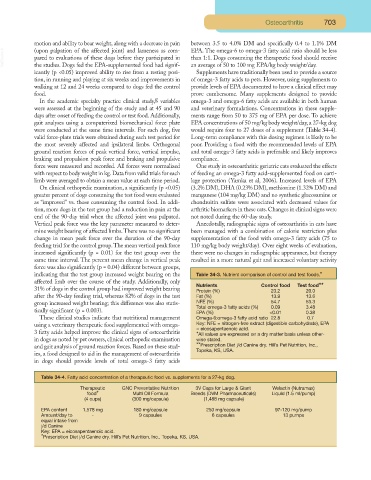Page 679 - Small Animal Clinical Nutrition 5th Edition
P. 679
Osteoarthritis 703
motion and ability to bear weight, along with a decrease in pain between 3.5 to 4.0% DM and specifically 0.4 to 1.1% DM
VetBooks.ir (upon palpation of the affected joint) and lameness as com- EPA. The omega-6 to omega-3 fatty acid ratio should be less
than 1:1. Dogs consuming the therapeutic food should receive
pared to evaluations of these dogs before they participated in
an average of 50 to 100 mg EPA/kg body weight/day.
the studies. Dogs fed the EPA-supplemented food had signif-
icantly (p <0.05) improved ability to rise from a resting posi- Supplements have traditionally been used to provide a source
tion, in running and playing at six weeks and improvements in of omega-3 fatty acids to pets. However, using supplements to
walking at 12 and 24 weeks compared to dogs fed the control provide levels of EPA documented to have a clinical effect may
food. prove cumbersome. Many supplements designed to provide
g
In the academic specialty practice clinical study, variables omega-3 and omega-6 fatty acids are available in both human
were assessed at the beginning of the study and at 45 and 90 and veterinary formulations. Concentrations in these supple-
days after onset of feeding the control or test food. Additionally, ments range from 50 to 375 mg of EPA per dose. To achieve
gait analyses using a computerized biomechanical force plate EPA concentrations of 50 mg/kg body weight/day, a 27-kg dog
were conducted at the same time intervals. For each dog, five would require four to 27 doses of a supplement (Table 34-4).
valid force-plate trials were obtained during each test period for Long-term compliance with this dosing regimen is likely to be
the most severely affected and ipsilateral limbs. Orthogonal poor. Providing a food with the recommended levels of EPA
ground reaction forces of peak vertical force, vertical impulse, and total omega-3 fatty acids is preferable and likely improves
braking and propulsion peak force and braking and propulsive compliance.
force were measured and recorded. All forces were normalized One study in osteoarthritic geriatric cats evaluated the effects
with respect to body weight in kg. Data from valid trials for each of feeding an omega-3 fatty acid-supplemented food on carti-
limb were averaged to obtain a mean value at each time period. lage protection (Yamka et al, 2006). Increased levels of EPA
On clinical orthopedic examination, a significantly (p <0.05) (3.2% DM), DHA (0.23% DM), methionine (1.32% DM) and
greater percent of dogs consuming the test food were evaluated manganese (104 mg/kg DM) and no synthetic glucosamine or
as “improved” vs. those consuming the control food. In addi- chondroitin sulfate were associated with decreased values for
tion, more dogs in the test group had a reduction in pain at the arthritic biomarkers in these cats.Changes in clinical signs were
end of the 90-day trial when the affected joint was palpated. not noted during the 60-day study.
Vertical peak force was the key parameter measured to deter- Anecdotally, radiographic signs of osteoarthritis in cats have
mine weight bearing of affected limbs.There was no significant been managed with a combination of calorie restriction plus
change in mean peak force over the duration of the 90-day supplementation of the food with omega-3 fatty acids (75 to
feeding trial for the control group.The mean vertical peak force 110 mg/kg body weight/day). Over eight weeks of evaluation,
increased significantly (p = 0.01) for the test group over the there were no changes in radiographic appearance, but therapy
same time interval. The percent mean change in vertical peak resulted in a more natural gait and increased voluntary activity
force was also significantly (p = 0.04) different between groups,
indicating that the test group increased weight bearing on the Table 34-3. Nutrient comparison of control and test foods.*
affected limb over the course of the study. Additionally, only
Nutrients Control food Test food**
31% of dogs in the control group had improved weight bearing Protein (%) 23.2 20.0
after the 90-day feeding trial, whereas 82% of dogs in the test Fat (%) 13.9 13.6
group increased weight bearing; this difference was also statis- NFE (%) 54.7 53.3
Total omega-3 fatty acids (%) 0.09 3.48
tically significant (p = 0.003). EPA (%) <0.01 0.38
These clinical studies indicate that nutritional management Omega-6:omega-3 fatty acid ratio 22.8 0.7
using a veterinary therapeutic food supplemented with omega- Key: NFE = nitrogen-free extract (digestible carbohydrate), EPA
= eicosapentaenoic acid.
3 fatty acids helped improve the clinical signs of osteoarthritis *All values are expressed on a dry matter basis unless other-
in dogs as noted by pet owners, clinical orthopedic examination wise stated.
and gait analysis of ground reaction forces.Based on these stud- **Prescription Diet j/d Canine dry. Hill’s Pet Nutrition, Inc.,
Topeka, KS, USA.
ies, a food designed to aid in the management of osteoarthritis
in dogs should provide levels of total omega-3 fatty acids
Table 34-4. Fatty acid concentration of a therapeutic food vs. supplements for a 27-kg dog.
Therapeutic GNC Preventative Nutrition 3V Caps for Large & Giant Welactin (Nutramax)
food* Multi Oil Formula Breeds (DVM Pharmaceuticals) Liquid (1.5 ml/pump)
(4 cups) (300 mg/capsule) (1,488 mg capsule)
EPA content 1,578 mg 180 mg/capsule 250 mg/capsule 97-120 mg/pump
Amount/day to - 9 capsules 6 capsules 13 pumps
equal intake from
j/d Canine
Key: EPA = eicosapentaenoic acid.
*Prescription Diet j/d Canine dry. Hill’s Pet Nutrition, Inc., Topeka, KS, USA.

